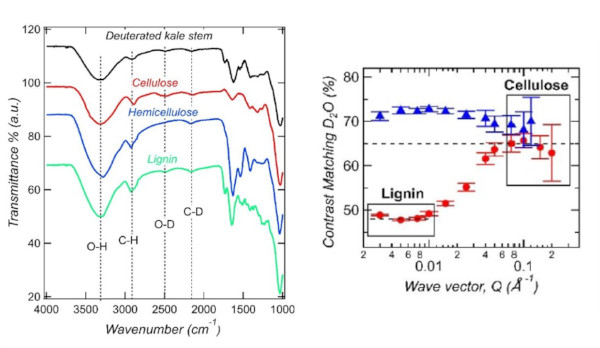Deuterium Labeling Reveals Structural Components of Plant Cell Walls
11/22/2023

Using Isotope Labeling to Differentiate Plant Cell Wall Components. Fourier transform infrared (FTIR) spectra (left) show deuterium (D) labeling of deuterated kale stem and its cellulose, hemicellulose, and lignin extracts, illustrating the method's ability to differentiate biopolymer components. SANS (right) reveals component plant polymers responsible for features in Q-ranges of 31% deuterated kale stem (red circles) and its extracted cellulose (blue triangles).
[Reprinted with permission from Yang et al. DOI:10.1021/acssuschemeng.3c04076. Copyright 2023 American Chemical Society.]
The Science
Plant cell walls have a complex structure consisting primarily of cellulose, hemicellulose, and lignin. These polymers come together to form an intricate laminate that confers an architecture advantageous for producing a strong and durable material. However, the interactions between the polymers and their distributions in cell walls are not well understood.
Plants grown in a mixture of water and heavy water (deuterium oxide; D2O) differentially incorporate deuterium into their cell wall polymers. Fourier transform infrared spectroscopy (FTIR) revealed that carbohydrate polymers incorporate more deuterium than lignin. Using this differential, structural characterization could be performed using small-angle neutron scattering (SANS), which demonstrated that cellulose and lignin fractions in cell walls can be spatially deconvoluted.
This approach can help improve understanding of polymer organization in plant cell walls and the changes that occur during their deconstruction to produce biofuels.
The Impact
Deuterium labeling increases the difference in neutron scattering length density between carbohydrate and lignin plant polymers, allowing deconvolution of the structural features of different component biopolymers without altering native cell wall structure. This approach will improve understanding of how cellulose, hemicellulose, and lignin interact during plant cell wall assembly as well as the structural changes that occur during biomass deconstruction for biofuels production.
The Summary
Brassica Oleracea (kale), a relative of bioenergy crops B. napus (rapeseed), and B. carinata (camelina) and a C3 plant (e.g., like poplar and most trees), was grown in a mixture of water and D2O. Incorporation of deuterium in the different plant polymers was determined using FTIR. Contrast variation small-angle neutron scattering (CV-SANS) was then used to structurally characterize the plant biomass. FTIR results showed higher deuterium incorporation in the carbohydrate fraction (~41%) compared to lignin (21%).
CV-SANS showed it was possible to separate the scattering signals of the different polymers, which is not possible using unlabeled plant cell walls. Lignin dominated the scattering intensity at longer spatial scales while cellulose was observed at shorter length scales.
Funding
This research was supported by the U.S. Department of Energy (DOE), Office of Science, through the Genomic Science Program, Biological and Environmental Research program (BER), under Contract FWP ERKP752. The research at Oak Ridge National Laboratory’s Center for Structural Molecular Biology was supported by DOE, Office of Science, through BER under Contract FWP ERKP291, using facilities supported by the DOE Basic Energy Sciences program.
Related Links
References
Yang et al. 2023. “Deconvoluting Structures of Component Plant Biopolymers Using Deuterium-Labeled Brassica oleracea Stems,” ACS Sustainable Chemistry & Engineering 11, 17238–48. DOI:10.1021/acssuschemeng.3c04076.
